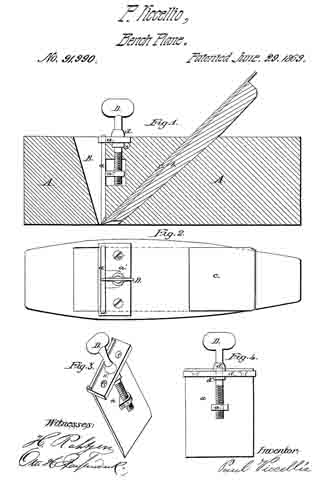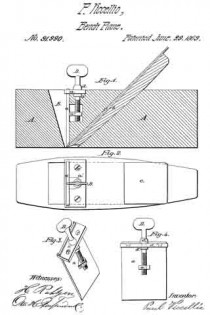
| PLEASE NOTE: The images presented on this page are of low resolution and, as a result, will not print out very well. If you wish to have higher resolution files then you may purchase them for only $2.95 per patent by using the "Buy Now" button below. All purchases are via PayPal. These files have all been cleaned up and digitally enhanced and are therefore suitable for printing, publication or framing. Each zip package contains all the images below (some packages may contain more), and purchased files can be downloaded immediately. |
United States Patent Office.
PAUL VICCELLIO, OF NEW ORLEANS, LOUISIANA.
Letters Patent No. 91,990, dated June 29, 1869.
_________________
IMPROVEMENT IN WOOD-PLANE.
_________________
The Schedule referred to in these Letters Patent and making part of the same.
_________________
To all whom it may concern:
Be it known that I, PAUL VICCELLIO, of the city of New Orleans, in the State of Louisiana, have invented new and valuable Improvements in Wood-Planes; and I do hereby declare that the following is a full and exact description thereof; reference being had to the accompanying drawings, and to the letters of reference marked thereon.
The object of this invention is to so construct aplane that the cap may be nicely adjusted upon the plane-bit, without regard to the distance that said bit may project beyond or below the face of the plane; and lt consists of the sliding adjustable, and perpendicular cap, as applied to and adjusted upon the plane bit.
Figure 1 is a longitudinal section of the plane;
Figure 2 is a top view ofthe plane;
Figure 3 is a perspective view of the cap and its attachments for operating it; and
Figure 4 is a back view of same.
To enable others skilled in the art to make and use my invention, I will describe its construction and operation.
A represents the wood or stock of a common smooth plane.
b is the holding-wedge to plane-bit c. The plane-bit c is set at an acute angle to the face of the plane, in order to secure an easy cut by the bit.
B represents the throat of the plane, with the rear or back side perpendicular, as seen in fig. 1.
Into the wood of the plane, on its top, is a metal plate, a’, sunk flush with the wood, and held in its place by screws e’, through holes e in plate a.
The front edge of plate a’ is recessed nearly its whole length, or so as to receive cap a in grooves that are cut therein, as seen in figs. 2 and 3, and in said grooves the cap a can freely slide.
Upon the back side of cap a is a lug-nut, a”, having a female screw-thread therein.
There is a thumb-screw D, having collars d and d’, upon each side of plate a’, so that it is securely held in its position, and upon the lower end is out a screw-thread which enters into lug-nut a”, and by turning the thumb-screw, the cap a is raised or depressed, as may be desired.
Cap a is acutely bevelled on its rear lower edge, so as to present a sharp edge upon the plane-bit c, as seen in fig. 1, and it can readily be seen that by depressing the cap by means of screw D, the most delicate adjustment of the cap upon the plane-bit can be obtained. The bit c can be taken out of the stock A, by releasing wedge b, which, in order to hold the bit firmly in position tbr cap a to act upon, is put in the rear side of said bit c, and is just as effective in holding, adjusting, or releasing the bit, as if it was placed betore it.
By placing the cap a in a perpendicular, and the bit at an acute angle with the face of the plane, the shaving is easily severed from the wood, and the cap a crimps the sharing, and insures a clear smooth out upon the wood, however cross-grained or knotty the wood may be. At the same time the cap is straight on its face, causing only a single bend of the shaving to follow up the face of the cup through the throat and out ot’ the plane, without, in the least, clogging or crimping.
The parts are all simple and cheap in construction and operation, less liable to get out of order by reason of the fewer parts, and making, as a whole, a plane of less cost, more effective and satisfactory in its use, and less trouble to manage while so in use.
I am aware that there are many devices for adjusting plane-bits in the stock, as well as many for adjusting the cap upon the bit.
I am also aware of the plane described in Patent No. 50,378, where the cap is adjusted by means of a set-screw upon the plane-bit.
None of the devices therein described do I claim, as the construction of that plane is more expensive, has more parts, thus increasing the liability to get out of repair, and so constructed that the shaving has to go through a secondary bend to be successfully discharged from the plane.
My improvement can be applied to all kinds of planes, such as jack or fore-planes, and jointers, as well as smooth-planes.
Having thus described my invention,
What I claim, and desire to secure by Letters Patent, is —
The above-described plane, when composed of the combination of the bit c, wedge b, cap a, and its adjusting-devices, with the stock A, all constructed to operate in the manner and tbr the purpose substantially as described.
PAUL VICCELLIO.
Witnesses:
WM. MANTEY,
F. LURGES.


